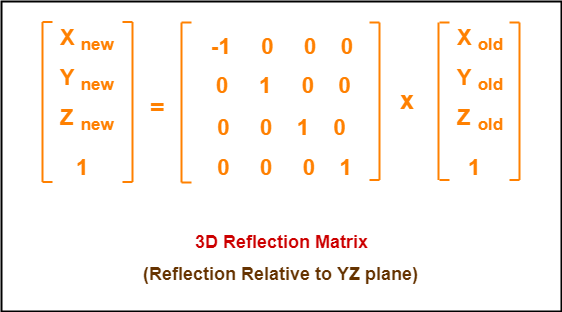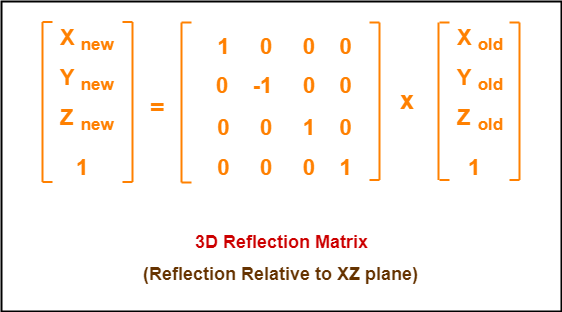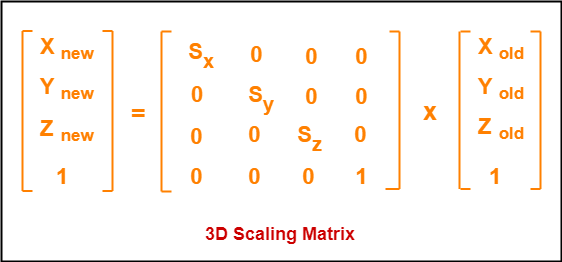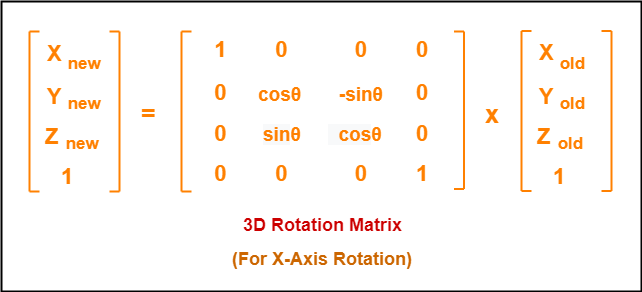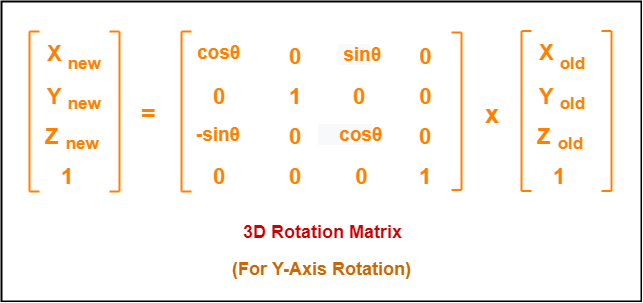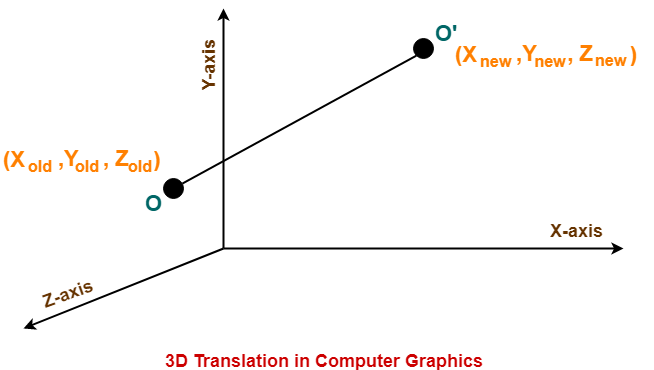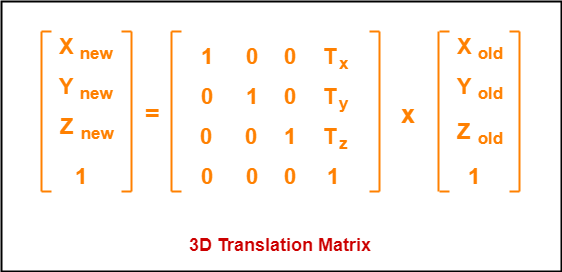3D Transformations in Computer Graphics-
We have discussed-
- Transformation is a process of modifying and re-positioning the existing graphics.
- 3D Transformations take place in a three dimensional plane.
In computer graphics, various transformation techniques are-
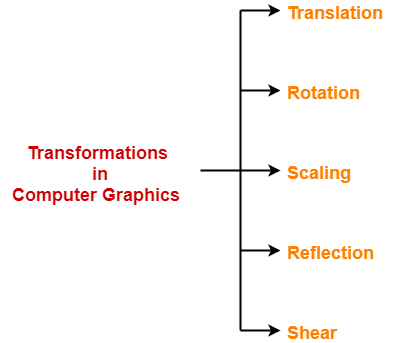
In this article, we will discuss about 3D Shearing in Computer Graphics.
3D Shearing in Computer Graphics-
| In Computer graphics,
3D Shearing is an ideal technique to change the shape of an existing object in a three dimensional plane. |
In a three dimensional plane, the object size can be changed along X direction, Y direction as well as Z direction.
So, there are three versions of shearing-

- Shearing in X direction
- Shearing in Y direction
- Shearing in Z direction
Consider a point object O has to be sheared in a 3D plane.
Let-
- Initial coordinates of the object O = (Xold, Yold, Zold)
- Shearing parameter towards X direction = Shx
- Shearing parameter towards Y direction = Shy
- Shearing parameter towards Z direction = Shz
- New coordinates of the object O after shearing = (Xnew, Ynew, Znew)
Shearing in X Axis-
Shearing in X axis is achieved by using the following shearing equations-
- Xnew = Xold
- Ynew = Yold + Shy x Xold
- Znew = Zold + Shz x Xold
In Matrix form, the above shearing equations may be represented as-
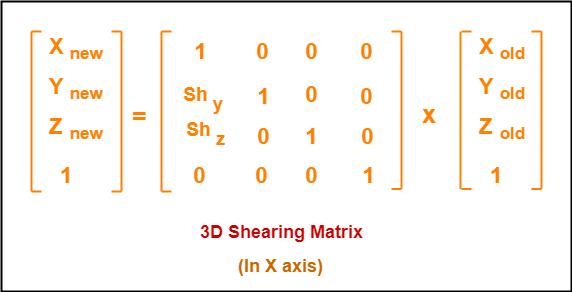
Shearing in Y Axis-
Shearing in Y axis is achieved by using the following shearing equations-
- Xnew = Xold + Shx x Yold
- Ynew = Yold
- Znew = Zold + Shz x Yold
In Matrix form, the above shearing equations may be represented as-
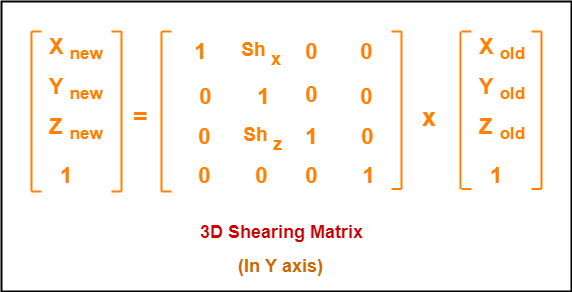
Shearing in Z Axis-
Shearing in Z axis is achieved by using the following shearing equations-
- Xnew = Xold + Shx x Zold
- Ynew = Yold + Shy x Zold
- Znew = Zold
In Matrix form, the above shearing equations may be represented as-
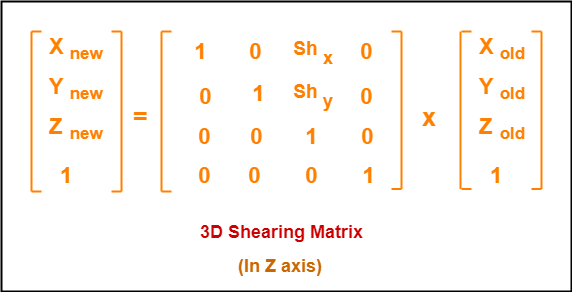
PRACTICE PROBLEMS BASED ON 3D SHEARING IN COMPUTER GRAPHICS-
Problem-01:
Given a 3D triangle with points (0, 0, 0), (1, 1, 2) and (1, 1, 3). Apply shear parameter 2 on X axis, 2 on Y axis and 3 on Z axis and find out the new coordinates of the object.
Solution-
Given-
- Old corner coordinates of the triangle = A (0, 0, 0), B(1, 1, 2), C(1, 1, 3)
- Shearing parameter towards X direction (Shx) = 2
- Shearing parameter towards Y direction (Shy) = 2
- Shearing parameter towards Y direction (Shz) = 3
Shearing in X Axis-
For Coordinates A(0, 0, 0)
Let the new coordinates of corner A after shearing = (Xnew, Ynew, Znew).
Applying the shearing equations, we have-
- Xnew = Xold = 0
- Ynew = Yold + Shy x Xold = 0 + 2 x 0 = 0
- Znew = Zold + Shz x Xold = 0 + 3 x 0 = 0
Thus, New coordinates of corner A after shearing = (0, 0, 0).
For Coordinates B(1, 1, 2)
Let the new coordinates of corner B after shearing = (Xnew, Ynew, Znew).
Applying the shearing equations, we have-
- Xnew = Xold = 1
- Ynew = Yold + Shy x Xold = 1 + 2 x 1 = 3
- Znew = Zold + Shz x Xold = 2 + 3 x 1 = 5
Thus, New coordinates of corner B after shearing = (1, 3, 5).
For Coordinates C(1, 1, 3)
Let the new coordinates of corner C after shearing = (Xnew, Ynew, Znew).
Applying the shearing equations, we have-
- Xnew = Xold = 1
- Ynew = Yold + Shy x Xold = 1 + 2 x 1 = 3
- Znew = Zold + Shz x Xold = 3 + 3 x 1 = 6
Thus, New coordinates of corner C after shearing = (1, 3, 6).
Thus, New coordinates of the triangle after shearing in X axis = A (0, 0, 0), B(1, 3, 5), C(1, 3, 6).
Shearing in Y Axis-
For Coordinates A(0, 0, 0)
Let the new coordinates of corner A after shearing = (Xnew, Ynew, Znew).
Applying the shearing equations, we have-
- Xnew = Xold + Shx x Yold = 0 + 2 x 0 = 0
- Ynew = Yold = 0
- Znew = Zold + Shz x Yold = 0 + 3 x 0 = 0
Thus, New coordinates of corner A after shearing = (0, 0, 0).
For Coordinates B(1, 1, 2)
Let the new coordinates of corner B after shearing = (Xnew, Ynew, Znew).
Applying the shearing equations, we have-
- Xnew = Xold + Shx x Yold = 1 + 2 x 1 = 3
- Ynew = Yold = 1
- Znew = Zold + Shz x Yold = 2 + 3 x 1 = 5
Thus, New coordinates of corner B after shearing = (3, 1, 5).
For Coordinates C(1, 1, 3)
Let the new coordinates of corner C after shearing = (Xnew, Ynew, Znew).
Applying the shearing equations, we have-
- Xnew = Xold + Shx x Yold = 1 + 2 x 1 = 3
- Ynew = Yold = 1
- Znew = Zold + Shz x Yold = 3 + 3 x 1 = 6
Thus, New coordinates of corner C after shearing = (3, 1, 6).
Thus, New coordinates of the triangle after shearing in Y axis = A (0, 0, 0), B(3, 1, 5), C(3, 1, 6).
Shearing in Z Axis-
For Coordinates A(0, 0, 0)
Let the new coordinates of corner A after shearing = (Xnew, Ynew, Znew).
Applying the shearing equations, we have-
- Xnew = Xold + Shx x Zold = 0 + 2 x 0 = 0
- Ynew = Yold + Shy x Zold = 0 + 2 x 0 = 0
- Znew = Zold = 0
Thus, New coordinates of corner A after shearing = (0, 0, 0).
For Coordinates B(1, 1, 2)
Let the new coordinates of corner B after shearing = (Xnew, Ynew, Znew).
Applying the shearing equations, we have-
- Xnew = Xold + Shx x Zold = 1 + 2 x 2 = 5
- Ynew = Yold + Shy x Zold = 1 + 2 x 2 = 5
- Znew = Zold = 2
Thus, New coordinates of corner B after shearing = (5, 5, 2).
For Coordinates C(1, 1, 3)
Let the new coordinates of corner C after shearing = (Xnew, Ynew, Znew).
Applying the shearing equations, we have-
- Xnew = Xold + Shx x Zold = 1 + 2 x 3 = 7
- Ynew = Yold + Shy x Zold = 1 + 2 x 3 = 7
- Znew = Zold = 3
Thus, New coordinates of corner C after shearing = (7, 7, 3).
Thus, New coordinates of the triangle after shearing in Z axis = A (0, 0, 0), B(5, 5, 2), C(7, 7, 3).
To gain better understanding about 3D Shearing in Computer Graphics,
Next Article- Bezier Curves
Get more notes and other study material of Computer Graphics.
Watch video lectures by visiting our YouTube channel LearnVidFun.


